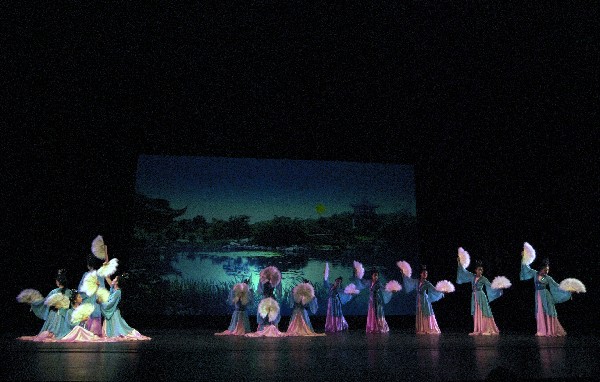
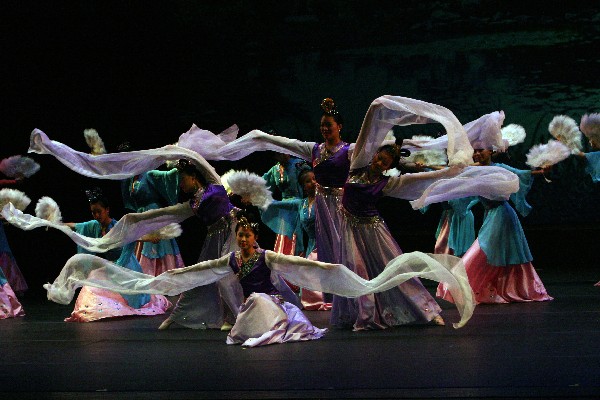
Atlanta Chinese Dance Company
presents
Nu: Past and Present
CLICK
HERE FOR PROGRAM SYNOPSIS
on
Saturday, October 13, 2007 at 7:30 PM
Sunday, October 14, 2007 at 2:00 PM
at
Performing Arts Center at Gwinnett Center
Duluth, Georgia
Staged and Directed by:
Hwee-Eng Y. Lee
Guest Artists:
Li-Chuan Lin, Atlanta Ballet
Hoyi Chan
Photographers:
Eric Chang
Hangdong Xu, Dance China NY
Kelsey Yip, Atlanta Ballet
Kerry Lee
Hui-Ju Young
David Goodwin
Ryan Nubel
Lander Stoddard
Christine Zahniser
|
Click on a dance to see its description: |
|
|
WOMEN OF CHINA'S DYNASTIES 1. Moonlight Over the Spring River 3. Pipa Xing 4. Zhu Yingtai 5. Dance of the Manchurian Concubines 6. Warring Drums on the Golden Mountain 9. Ta Ge RURAL CHINESE WOMEN 10. Bean Harvest 11. Shan Niu |
12. Kite Dance 13. Women of the Yellow River Basin 14. Blow the Suona 15. Dai Dance - It's a Beautiful Place 16. Dai Dance - Rain Bamboo Forest 17. Xinjiang Dance - Happy Celebration 18. Tibet Dance - Lucky Drum Dance 19. Mongolian Dance - Grassland Girls CHINESE WOMEN TODAY 20. Go to School 21. A Green Leaf 22. Nu 2007
|
1. MOONLIGHT OVER THE SPRING RIVER


The choreography of this well-known classical Chinese dance was designed to accompany a classical tune of the same name. It creates a serene picture of ancient Chinese ladies who are dancing under the moonlight, expressing their yearning with the gracious movements of the feather fans.
Choreographers: Margaret Yuen (Feather Fan); Hwee-Eng Y. Lee (Long Sleeves)
Long Sleeves Dancers: Grace Ho, April Huang, Melissa Ting, Kimberly Wu
Feather Fan Dancers: Catherine Chu, Stephanie Hu, Jessica Kouch, Katie Ku, Allison Kwan, Alda Lee, Tiffany Liu, Lindsey Lue, Michelle McIntire, Tanya Su, Georgia Tse, Alice Yee, Amy Yee

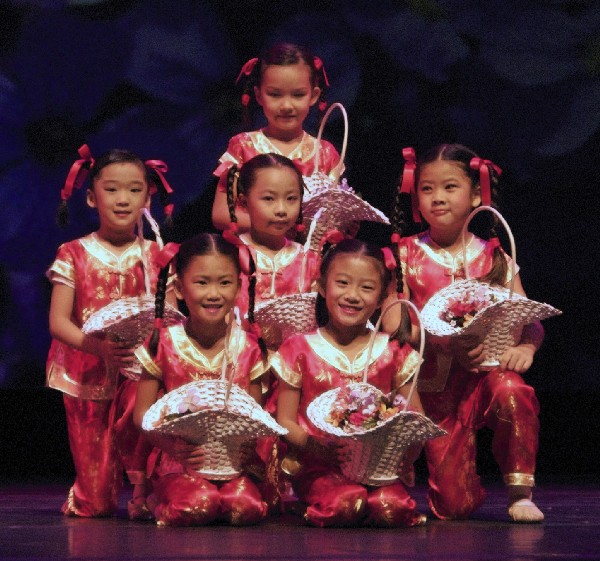
This dance depicts a group of young girls playing in the garden.
Choreography: Hwee-Eng Y. Lee
Dancers: Yi-Shan Bernard, Tia Bi, Sarah Anne Marie Goodwin, Hilary Hsieh,
Indigo Lee, Jade Leslie, Mia Mercaldo, Jessica Ye
3. PIPA XING
The
pipa is a traditional Chinese musical instrument. This dance was
choreographed based on a famous poem written by Bai Juyi. In 815, Bai
suddenly heard a pipa tune on a harbor on the Yangtze River. He learned
that the musician was formerly a famous star in the capital but was later forced
to lower herself to marry a merchant after her beauty faded. Her sadness
reminded Bai of his own recent demotion, and he wrote this poem for her.
Choreography: Guangzhou Jun Qu Zhan Shi Music and Dance Troupe (National
Dance Competition Award-Winning Piece)
Dancer: Queena Kou
Zhu
Yingtai is the female protagonist in the famous Chinese legend The Butterfly
Lovers, which is often regarded as the Chinese equivalent of Romeo and
Juliet. In the Eastern Jin Dynasty (265-420), women were not permitted
to leave home to attend school; thus, Zhu Yingtai disguised herself as a man to
study in Hangzhou. This dance depicts the joyfulness of the opportunity to
attain knowledge. At times, the fan represents a book.
Choreography: Beijing
Dance Academy (Tao Li Cup Competition Award-Winning Piece)
Dancer: Catherine Chu (Saturday); Allison Kwan (Sunday)
5. DANCE OF THE MANCHURIAN CONCUBINES
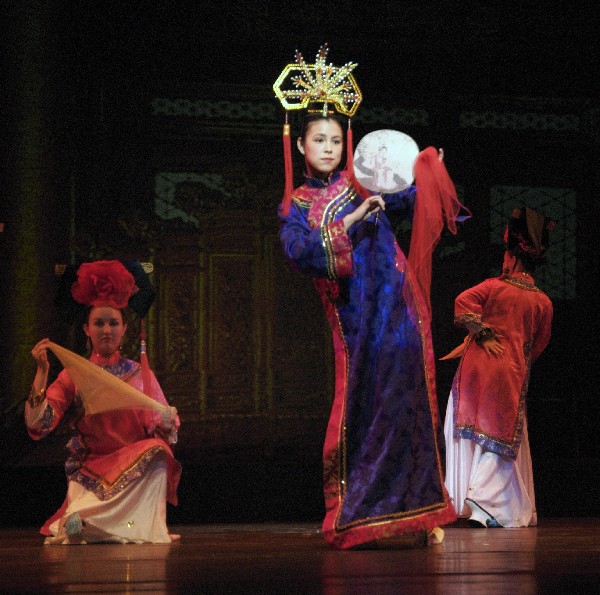
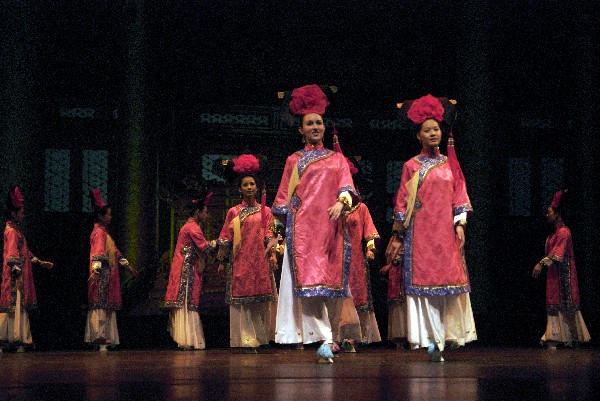 The
Qing (or Manchu) Dynasty (1644-1911) was the last dynasty of China's dynastic
cycle. The dynasty was founded by the Manchu people, one of the fifty-six
minority ethnic groups in China. The exquisite costumes of this piece were
fashioned after the royalty in the Imperial Palace. Their distinctive
style includes tall headdresses and "flower bowl" platform shoes.
The
Qing (or Manchu) Dynasty (1644-1911) was the last dynasty of China's dynastic
cycle. The dynasty was founded by the Manchu people, one of the fifty-six
minority ethnic groups in China. The exquisite costumes of this piece were
fashioned after the royalty in the Imperial Palace. Their distinctive
style includes tall headdresses and "flower bowl" platform shoes.
Choreographer: Yu Hong
Lead Dancer: Catherine Stoddard (Saturday); Emery Chang (Sunday)
Group Dancers: Irene Chien, Autumn Coleman, Justina Ho, Chanie Howard,
April Huang, Angela Liu, Emily Pau, Julia Shyu, Melissa Ting, Nora Yunfan Zhang
6.
WARRING DRUMS ON THE GOLDEN MOUNTAIN
This
classical Chinese dance portrays a Song Dynasty (960-1279) war heroine Liang
Hongyu drumming in the battlefields. Many of the dance movements are
derived from traditional Chinese opera. These movements create an image of
a woman who is both brave and elegant. Liang Hongyu's fearlessness and
confidence made her an unforgettable war general. She was one of the few
war heroines of ancient Chinese history.
Choreographer: Yong Jia
Chen
Dancer: Hui-Ju Young (Guest Artist)
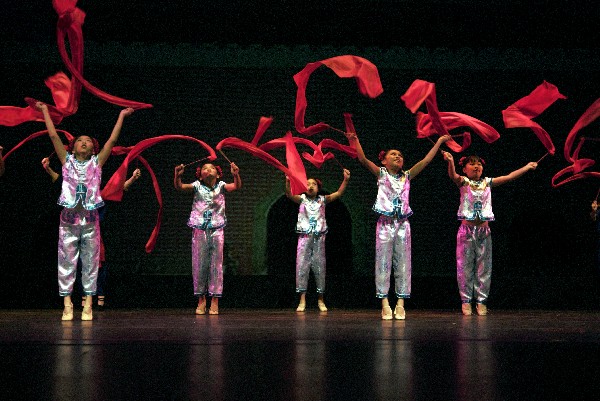 This
dance showcases the spirit of celebration after a victorious battle. The
excitement is depicted by drumming sounds combined with flowing red ribbons.
Traditionally, red is a symbol of happiness. For centuries, Chinese have
taken great pride in producing beautiful silk ribbons. Ribbon dancing
originated from Chinese opera has been preserved since the Han dynasty (206
BC-AD 24) It has since become a Han ethnic tradition, commonly performed
at celebrations.
This
dance showcases the spirit of celebration after a victorious battle. The
excitement is depicted by drumming sounds combined with flowing red ribbons.
Traditionally, red is a symbol of happiness. For centuries, Chinese have
taken great pride in producing beautiful silk ribbons. Ribbon dancing
originated from Chinese opera has been preserved since the Han dynasty (206
BC-AD 24) It has since become a Han ethnic tradition, commonly performed
at celebrations.
Watch the video here!
Choreographer: Hwee-Eng Y. Lee
Dancers: June Brenner, Carolyn Butler, Freda Chen, Katherine Do, Andrew
Ellis, Nia Nguyen, Jade Phillips, Anna Rappaport, Emily Ye, Andrew Young
8. FORBIDDEN LOVE
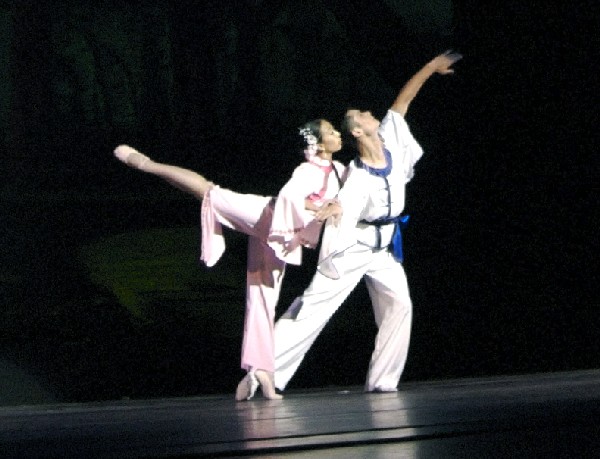
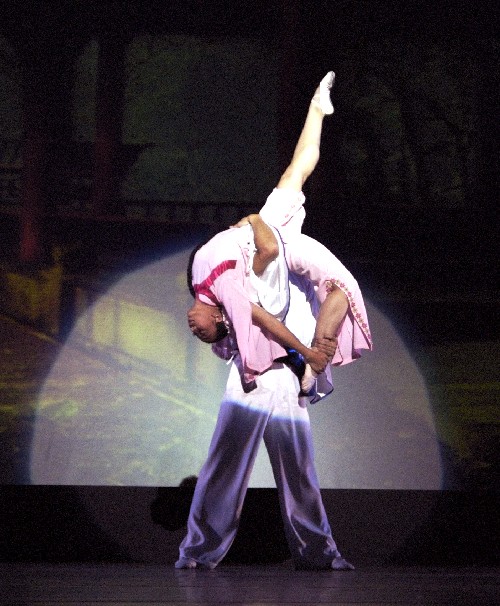 This
classical Chinese dance pas de deux depicts two young lovers meeting in secrecy.
In Imperial China, marriages were generally arranged by matchmakers at a very
young age. Thus, women were often forbidden from seeing their true love.
This dance illustrates the lovers' sorrow at the prospect of never seeing each
other again.
This
classical Chinese dance pas de deux depicts two young lovers meeting in secrecy.
In Imperial China, marriages were generally arranged by matchmakers at a very
young age. Thus, women were often forbidden from seeing their true love.
This dance illustrates the lovers' sorrow at the prospect of never seeing each
other again.
Watch the video here!
Choreography:
Liang Qun and Liu Qi (National Lotus Dance Competition Award-Winning Piece)
Dancers: Kerry Lee (Guest Artist) and Hangdong Xu (Guest Artist, Dance
China NY)
9. TA GE
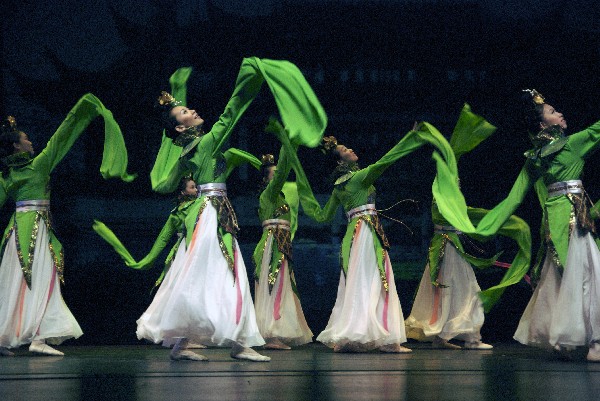 Ta
Ge literally means "tapping with the song" in Chinese. This dance style
originated from folklife during the Han Dynasty over 2,000 years ago and became
very widespread by the Tang Dynasty (618-907). The piece paints a picture
of a group of young ladies enjoying a beautiful day outdoors. The
choreographer incorporated various sleeve techniques from the Han, Tang, Song,
and Qing dynasties into a unique classical Chinese dance with a contemporary
twist.
Ta
Ge literally means "tapping with the song" in Chinese. This dance style
originated from folklife during the Han Dynasty over 2,000 years ago and became
very widespread by the Tang Dynasty (618-907). The piece paints a picture
of a group of young ladies enjoying a beautiful day outdoors. The
choreographer incorporated various sleeve techniques from the Han, Tang, Song,
and Qing dynasties into a unique classical Chinese dance with a contemporary
twist.
Choreography:
Sun Yun (National Lotus Dance Competition Award-Winning Piece)
Dancers: Emery Chang, Autumn Coleman, Grace Ho, Justina Ho, Chanie
Howard, April Huang, Queena Kou, Angela Liu, Eugenie Ooi, Julia Shyu, Catherine
Stoddard, Melissa Ting, Emily Wang, Kimberly Wu
10.
BEAN HARVEST
Soy
beans are one of the major ingredients in Chinese food. This Chinese folk
dance depicts a group of Han village girls harvesting soy beans and cooking soy
milk.
Choreography: Huai Nan
Shi Number Four Primary School
Dancers: Mei-Jing Bernard, Laura Brockmann, Claire Chang, Ruby Freeman,
Monica Ho, Lacey Krakowiak, Shannon Leeman, Tiffany Leeman, Rachel Leong, Alice
Y. McCurley, Penny Young
11. SHAN NIU
 "Shan"
is translated as mountain and "niu" as young girl. This Chinese folk dance
depicts a Han village girl playing on the street. The choreographer
utilizes traditional handkerchief techniques to show the playfulness of the
girl.
"Shan"
is translated as mountain and "niu" as young girl. This Chinese folk dance
depicts a Han village girl playing on the street. The choreographer
utilizes traditional handkerchief techniques to show the playfulness of the
girl.
Choreography: Shanghai Drama Academy (Tao Li Cup Competition Award-Winning Piece)
Dancer: Kateri Goodwin (Saturday); Anna Meyer (Sunday)
12. KITE DANCE
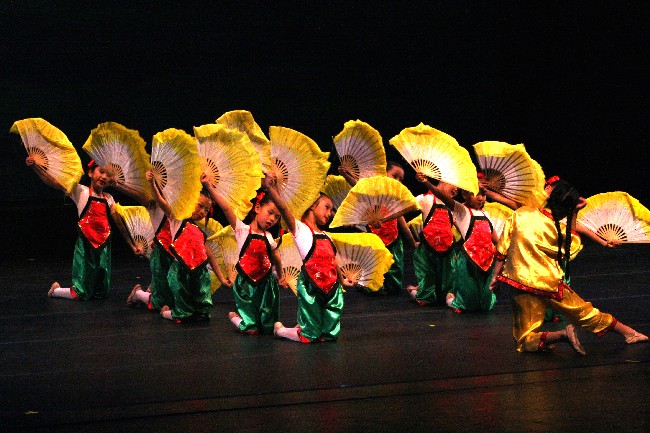 Kite-making
is a Chinese handicraft. The Chinese word for kite is "feng zheng."
"Feng" means wind and "zheng" is a Chinese musical instrument. The name
originated from a person named Li Ye from the tenth century who fastened a
bamboo whistle to a kite. Flying high overhead in the wind, the whistle
sounded like the Chinese musical instrument. In this Han folk dance a
young girl flies a kite, which is represented by group dancers who create
various shapes with fans.
Kite-making
is a Chinese handicraft. The Chinese word for kite is "feng zheng."
"Feng" means wind and "zheng" is a Chinese musical instrument. The name
originated from a person named Li Ye from the tenth century who fastened a
bamboo whistle to a kite. Flying high overhead in the wind, the whistle
sounded like the Chinese musical instrument. In this Han folk dance a
young girl flies a kite, which is represented by group dancers who create
various shapes with fans.
Choreography:
Hwee-Eng Y. Lee
Girl: Kate Zahniser-Word (Saturday); Sophie Archer (Sunday)
Group Dancers: Yi-Shan Bernard, Tia Bi, Mia I-Wah Chan, Sarah Anne Marie Goodwin, Camille Grough, Emma Grough, Hilary Hsieh, Indigo Lee, Jade Leslie, Mia Mercaldo, Jessica Ye
13. WOMEN OF THE
YELLOW RIVER BASIN
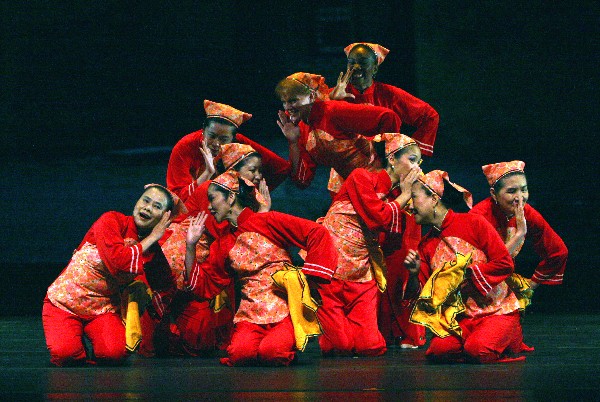 This
Han Chinese folk dance depicts the daily lives of village women in the Shanxi
province in the northern part of China. Their work includes activities
such as washing clothes, sewing, cooking, carrying the "biandan" (carrying
pole), and grinding rice. As they tackle a full day of hard work, they
gossip happily with each other.
This
Han Chinese folk dance depicts the daily lives of village women in the Shanxi
province in the northern part of China. Their work includes activities
such as washing clothes, sewing, cooking, carrying the "biandan" (carrying
pole), and grinding rice. As they tackle a full day of hard work, they
gossip happily with each other.
Choreography:
Shanxi Province Song and Dance Troupe
Dancers: Dawn Causey, Maggie Chang, Nancy Chen, Irene Chien, Debbie
Ellis, Margery Hwang, Agate Lip, Iyabo Shabazz, Shu Wu, Shu-Fen Yang
14. BLOW THE
SUONA
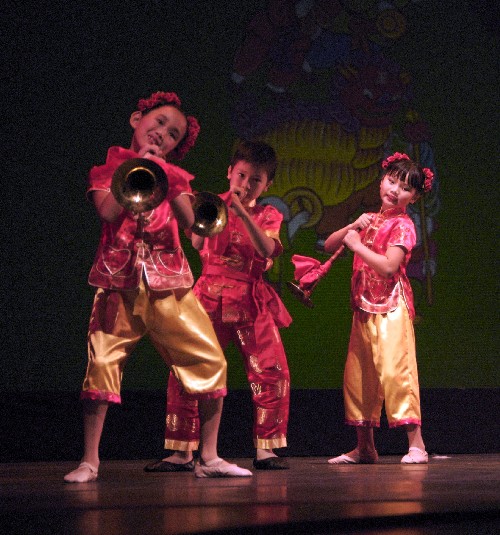 The
"suona" is a traditional Chinese musical instrument that closely resembles a
trumpet. Often called "laba," it first appeared in the Wei and Jin period
(200-42) and has found great favor since the reign of the Zhengde Emperor of the
Ming Dynasty (1505-1521). The loud volume of the "suona" is most
appropriate for an ardent and lively style, particularly for the imitation of
the song of hundred birds. The instrument is commonly used as
accompaniment in local theaters, singing and dancing, or on such occasions as
weddings, funerals, or other ceremonies. In this Han folk dance piece, the
boys and girls compete with one another for the loudest volume.
The
"suona" is a traditional Chinese musical instrument that closely resembles a
trumpet. Often called "laba," it first appeared in the Wei and Jin period
(200-42) and has found great favor since the reign of the Zhengde Emperor of the
Ming Dynasty (1505-1521). The loud volume of the "suona" is most
appropriate for an ardent and lively style, particularly for the imitation of
the song of hundred birds. The instrument is commonly used as
accompaniment in local theaters, singing and dancing, or on such occasions as
weddings, funerals, or other ceremonies. In this Han folk dance piece, the
boys and girls compete with one another for the loudest volume.
Choreography: China Shou-La-Shou Arts Troupe
Dancers: June Brenner, Carolyn Butler, Freda Chen, Katherine Do, Andrew
Ellis, Julie Hon, Anna Marianchuk, Nia Nguyen, Jade Phillips, Anna Rappaport,
Emily Ye, Andrew Young
15. DAI DANCE -
THERE IS A BEAUTIFUL PLACE
 The
Dai people are one of the fifty-six minority ethnic groups in China. They
live mostly in the Yunnan province located in the southwestern part of China.
Because of their close proximity to Myanmar, Dai dance is very similar to
Burmese dance. This piece was originally choreographed for ACDC by Tang
Yebi, a Dai lady.
The
Dai people are one of the fifty-six minority ethnic groups in China. They
live mostly in the Yunnan province located in the southwestern part of China.
Because of their close proximity to Myanmar, Dai dance is very similar to
Burmese dance. This piece was originally choreographed for ACDC by Tang
Yebi, a Dai lady.
Choreographed by Hwee-Eng Y. Lee after Tang Yebi
Lead Dancer: Hoyi Chan (Guest Artist)
Group Dancers: Mei-Jing Bernard, Laura Brockmann, Claire Chang, Ruby
Freeman, Monica Ho, Lacey Krakowiak, Shannon Leeman, Tiffany Leeman, Rachel
Leong, Alice Y. McCurley, Grace Rawden, Penny Young
16. DAI DANCE -
RAIN BAMBOO FOREST
 The
Dai people live in an area abundant in bamboo. Thus, women have close
associations with bamboo products. In addition to bamboo-made houses,
there are records of stories, folklore, and myths about bamboo. In this
piece, the dancers wears a hat made of bamboo.
The
Dai people live in an area abundant in bamboo. Thus, women have close
associations with bamboo products. In addition to bamboo-made houses,
there are records of stories, folklore, and myths about bamboo. In this
piece, the dancers wears a hat made of bamboo.
Choreography: Central University for Nationalities (Tao Li Cup Competition Award-Winning Piece)
Dancer: Eugenie Ooi
17. XINJIANG DANCE -
HAPPY CELEBRATION
 The
Ughyer (or "wei wu er") people are on of the fifty-six minority ethnic groups in
China. They live mostly in the Xinjiang Ughyer Autonomous Region located
in the northwestern part of China, which is close to the Middle East.
Ughyer people love music and dance. It is a crucial element for every
social gathering. Intricate wrist and neck movements are the distinct
characteristics of their style.
The
Ughyer (or "wei wu er") people are on of the fifty-six minority ethnic groups in
China. They live mostly in the Xinjiang Ughyer Autonomous Region located
in the northwestern part of China, which is close to the Middle East.
Ughyer people love music and dance. It is a crucial element for every
social gathering. Intricate wrist and neck movements are the distinct
characteristics of their style.
Choreography: Urumqi Shao Nian Gong
Dancers: Sophie Archer, Emily Backer, Christy Chang, Vera Chang, Marjorie Chamberlain, Kateri Goodwin, Madeleine Harris, Molly Herman-Gallow, Leslie Lue, Anna Meyer, Kate Zahniser-Word, Janie Wu
18. TIBET DANCE - LUCKY DRUM DANCE

The Tibetan people are one of the fifty-six minority ethnic groups in China. Most Tibetans live in the western part of China in areas such as Tibet, Qinghai, Yunnan, Gansu, and Sichuan. Their clothing typically includes a multi-colored apron and long sleeves. Because the weather can change rapidly in a single day, they often only wear one sleeve. The other sleeve is generally let off and tied around the waist. Herders sometimes wear sheepskin robes in place of a jacket.
Choreographer: Cai Rang
Za Xi
Dancers: Catherine Chu, Stephanie Hu, Jessica Kouch, Katie Ku, Allison
Kwan, Tiffany Liu, Lindsey Lue, Michelle McIntire, Tanya Su, Georgia Tse, Alice
Yee, Amy Yee
19. MONGOLIAN DANCE - GRASSLAND GIRLS
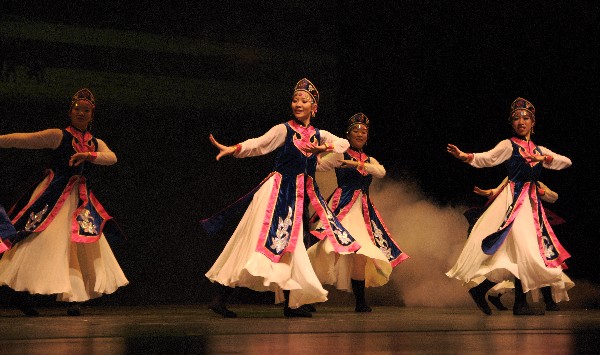 Mongolians
are one of the fifty-six minority ethnic groups in China. They live
primarily on vast prairies in the Inner Mongolian Autonomous Region in the
northern part of China. Many of the people live as shepherds. Their
traditional culture has a close relationship with sheep, horses, and eagles.
This dance is characterized by vigorous and energetic movements. Some of
the movements evoke the image of horseback riding.
Mongolians
are one of the fifty-six minority ethnic groups in China. They live
primarily on vast prairies in the Inner Mongolian Autonomous Region in the
northern part of China. Many of the people live as shepherds. Their
traditional culture has a close relationship with sheep, horses, and eagles.
This dance is characterized by vigorous and energetic movements. Some of
the movements evoke the image of horseback riding.
Watch the video here!
Choreography: Inner Mongolia Song and Dance Troupe
Dancers: Emery Chang, Grace Ho, April Huang, Queena Kou, Eugenie Ooi,
Catherine Stoddard, Melissa Ting, Emily Wang, Kimberly Wu
A group of village girls happily carry their book bags to school. They are proud of their village for building a school for them with great facilities. Being able to attend school is quite a privilege to the girls, as females were forbidden from attending in the past. They look forward to their graduation and their potential to contribute their knowledge to their home village.
Watch the video here!
Choreography: Nanjing Arts Academy
Dancers: Janie Wu (lead), Sophie Archer, Emily Backer, Christy Chang, Vera Chang, Marjorie Chamberlain, Kateri Goodwin, Madeleine Harris, Molly Herman-Gallow, Leslie Lue, Anna Meyer, Kate Zahniser-Word
This piece combines modern dance and
traditional Chinese fan dance techniques to illustrate multiple facest of the
contemporary Chinese woman. The freedom of movement in modern dance
represents individuality and hope for the future while the fan symbolizes
traditional Chinese values passed down from generation to generation. The
music for this piece, Yanni's "Nightingale," was composed by a western artist
and features a traditional Chinese flute. It was the first performance by
a western artist at Forbidden City in China and was broadcast on China Central
Television (CCTV) throughout the nation. It later inspired the
choreography of this piece. This exchange of cultures is a key aspect of
the lives of Chinese women today.
Watch the video here!
Choreography: Beijing Dance Academy (Tao Li Cup Competition Award-Winning Piece)
Dancer: Kerry Lee (Guest Artist)
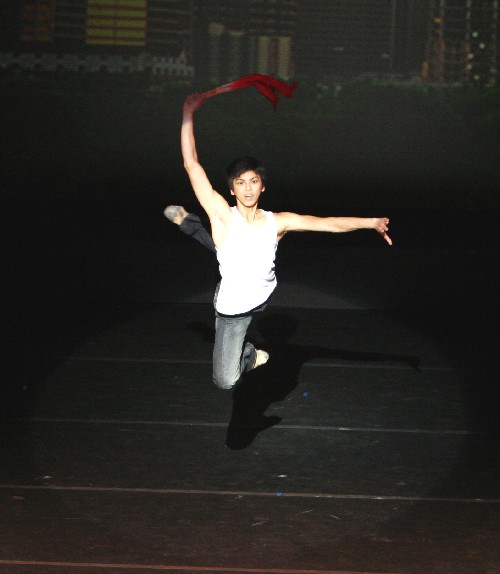
In today's increasingly global world, the lifestyles of Chinese women in both China and abroad are becoming increasingly similar to women of the western world. They are often dependent on technology such as cell phones, iPods, and laptops and are generally free to date men of their choice. This piece combines modern dance and traditional Chinese fan dance techniques to convey the intense, assertive character of contemporary Chinese women.
Staged by Hwee-Eng Y. Lee
after Bik Yim Yu of the Hong Kong Academy of the Performing Arts (Tao Li Cup
Competition Award-Winning Piece)
Male Lead Dancer: Li-Chuan Lin (Guest Artist, Atlanta Ballet)
Female Lead Dancers: Hoyi Chan (Guest Artist), Kerry Lee (Guest Artist),
Kelsey Yip (Guest Artist, Atlanta Ballet), Hui-Ju Young (Guest Artist)
Group Dancers: Emery Chang, Irene Chien, Autumn Coleman, Grace Ho,
Justina Ho, Chanie Howard, April Huang, Queena Kou, Angela Liu, Eugenie Ooi,
Emily Pau, Julia Shyu, Catherine Stoddard, Melissa Ting, Emily Wang, Kimberly Wu
Introduction
.|.
About
ACDC .|.
Past
Performances
Most
Recent Performance .|.
Upcoming Performance
.|.
Chinese
Dance History
Chinese
Dance Classes
Created by the Atlanta Chinese
Dance Company
Copyright reserved.